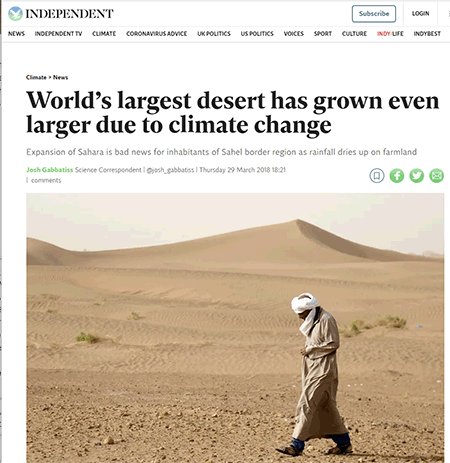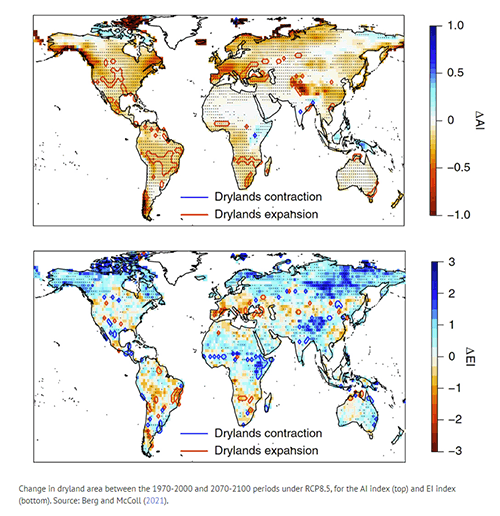After a thousand headlines told us Climate Change would make deserts grow, a new study suggests it won’t. It’s a finding that shocks no one who knew that climate models have no predictive skill with rainfall, and that a warmer world means higher global precipitation. Plus there’s the awkward clue that for the last forty years the arid regions of the world have been getting greener instead of more deserty.
Looks a bit different?
The top map (below) shows the deserts expanding — but that’s the old predictions which are based only on “atmospheric data” like temperature and rainfall. The bottom map is the new work which uses soil and vegetation data too. Red means growing deserts. Blue means shrinking.
Remember, all contradictory conclusions are based on expert opinions using worlds best practice and done by Nobel-Prize-winning people. Shame about all the farmers and investors making decisions based on junk models.
The new study is based on modeling too so it is still wrong, but less useless than previous studies.
The hugely different forecasts show how vaporously thin the past doom and gloom was, and how so many headlines were generated out of a banal omission from an inadequate model.
Cancel the cover shots of cracked Earth

Or not. | The Independent & nearly every other media outlet on Earth.
Now they tell us?
Now we find that all the past expert predictions were made with models that only used “atmospheric information” like rain and temperature — to predict the condition of plants and soil. You’d think they might have mentioned that. Now that they have some actual soil moisture data and flora involved — things look very different. As all good skeptics know (but apparently not science journalists) increasing CO2 means plants need less water. Thus more carbon dioxide makes plants “drought resistant”.
Note the attention getting headline:
Climate change may not expand drylands
Previous studies used atmospheric information, including rainfall and temperature, to make projections about future land conditions. The real picture is more complicated than that, said Kaighin McColl, Assistant Professor of Earth and Planetary Sciences and of Environmental Science and Engineering at SEAS and senior author of the paper.
“Historically, we have relatively good records of rainfall and temperature but really poor records of the land surface, things like soil moisture and vegetation,” said McColl. “As a result, previous definitions of drylands are based only on how the atmosphere is behaving, as an approximation of the land surface. But models can now simulate both atmospheric and land conditions. By just looking directly at the land surface in climate models, we find that the models aren’t showing a clear increase of drylands over time and that there is huge uncertainty about the global average state of drylands in the future.”
Plants need less water when there is more CO2:
While climate models have historically focused on the atmosphere, modern climate models now also simulate vegetation behavior and land hydrology.
For example, when plants absorb CO2, they lose water. If there is more CO2 in the air, plants can release less water and become more water efficient. More CO2 also results in more fertilizer for plants, which helps them grow and reduces water stress.
These effects have long been known, but previous atmospheric-only indicators of drylands just weren’t capturing these land surface effects.
What does “high confidence” mean anyway
The big news here, is less about deserts and more about what it says about consensuses and past media coverage. The IPCC says on “Desertification” that Risks from desertification are projected to increase due climate change (high confidence).” They knew that CO2 makes plants grow, but figured that the reduction in rain was more important. The problem was, and still is, that none of their models work for rainfall.
Past posts:
- Arid regions of the world are 11% greener, mostly thanks to CO2
- 18 million square kilometers more greenery due to “carbon pollution” that the Greens hate
h/t Willie Soon — join him on his Parler Account.
REFERENCE
Berg and McColl (2021) No projected global drylands expansion under greenhouse warming, Nature Climate Change.
The custom R code written to read and analyse the data and generate the figures is available on GitHub at https://doi.org/10.5281/zenodo.4490414 (ref. 51).
